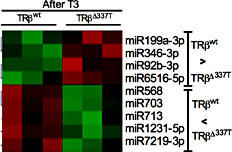Thyroid hormone (TH) signalling is critical for heart function. The heart expresses thyroid hormone receptors (THRs); THRα1 and THRβ1. Recently, a team of scientists led by researchers from Federal University of Rio de Janeiro aimed to investigate the regulation mechanisms of the THRβ isoform, its association with gene expression changes and implications for cardiac function. Their experiments were performed using adult male mice expressing TRβΔ337T, which contains the Δ337T mutation of the human THRB gene and impairs ligand binding. Cardiac function and RNA expression were studied after hypo-or hyperthyroidism inductions. T3-induced cardiac hypertrophy was not observed in TRβΔ337T mice, showing the fundamental role of THRβ in cardiac hypertrophy. Researchers identified a group of independently regulated THRβ genes, including Adrb2, Myh7 and Hcn2 that were normally regulated by T3 in the TRβΔ337T group. However, Adrb1, Myh6 and Atp2a2 were regulated via THRβ. The TRβΔ337T mice exhibited a contractile deficit, decreased ejection fraction and stroke volume, as assessed by echocardiography.
Using LC Sciences’ miRNA microarray service, researchers examined differential miRNA expression and determined that miR-208a and miR-199a may have contributed to THRβ-mediated cardiac hypertrophy, as indicated by the absence of T3-regulated ventricular expression in TRβΔ337T mice. Investigators conclude that THRβ plays an important role in the regulation of specific mRNA and miRNA in T3-induced cardiac hypertrophic growth and in the alteration of heart functions.
Differentially expressed miRNAs in the ventricles of T3-treated TRβWT and TRβΔ337T mice

Mouse miRNA was analysed by LC Sciences (Houston, TX). Nine miRNAs were differentially expressed (P<0.05): four miRNAs were down-regulated, and five were up-regulated in TRβΔ337T mice compared with TRβWT. Three animals were evaluated per group.
Related Service
miRNA Microarray Service – LC Sciences provides a microRNA (miRNA) expression profiling service using microarrays based on our in-house developed µParaflo® technology platform. We have standard arrays for all mature miRNAs of all species available in the latest version of the miRBase database (Release 21, July 2014). Our service is comprehensive and includes sample labeling, array hybridization, image data processing and in-depth data analysis. Two-three weeks after receiving your total RNA samples, we’ll send you both the raw and fully analyzed data. [Learn more…]
Reference
G.E. Império, I.P. Ramos, L.A. Santiago, G.F. Pereira, N.A. dos Santos Almeida, C.S. Fuziwara (2015) The Impact of a Non-Functional Thyroid Receptor Beta upon Triiodotironine-Induced Cardiac Hypertrophy in Mice Cell Physiol Biochem 7(2):477-90. [article]
